
The Boreal Forest
Reports - Boreal ConservationSeveral additional key reports articulate compelling arguments for conservation and protection of boreal forest areas as well as recommendations as to how to achieve these conservation objectives.Maps Show Boreal As Carbon Storehouse 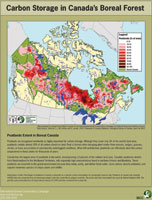 Canada's Boreal forest regions are the World's largest terrestrial carbon storehouse. New maps depicting the Boreal were released at the United Nations conference on climate change in Bali.
Canada's Boreal forest regions are the World's largest terrestrial carbon storehouse. New maps depicting the Boreal were released at the United Nations conference on climate change in Bali.The Canadian Boreal Forest regions play a key role in carbon storage for the planet. New maps prove global warming measures include protecting the Boreal Forest from deforestation and degradation. Three maps identify key factors for Boreal carbon storage abilities.
 Download Carbon Storage in Canada's Boreal Forest Maps (PDF) Download Carbon Storage in Canada's Boreal Forest Maps (PDF)Visit the International Boreal Conservation Campaign International Boreal Conservation Campaign
Greenpeace Canada  Download June 2007 Combating Climate Change Through Boreal Forest Conservation: Resistance, Adaptation, and Mitigation (PDF) Download June 2007 Combating Climate Change Through Boreal Forest Conservation: Resistance, Adaptation, and Mitigation (PDF)The Journal, Science 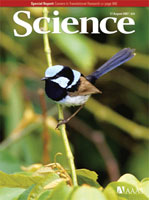 In the August 17, 2007 edition of the Journal, Science, researchers from the World Land Trust and the University of Leeds in England published a report that concludes that the restoration and protection of forests would result in a much greater reduction of the carbon load in the atmosphere than dedicating vast tracts of land to "energy crops".
In the August 17, 2007 edition of the Journal, Science, researchers from the World Land Trust and the University of Leeds in England published a report that concludes that the restoration and protection of forests would result in a much greater reduction of the carbon load in the atmosphere than dedicating vast tracts of land to "energy crops".The report assesses biofuels - produced by using everything from sugar cane to wheat - and compared carbon emissions associated with their use over the next 30 years. Energy crops require an enormous amount of land and clearing grasslands and forests to grow energy crops releases carbon stored in existing vegetation and soil. "In all cases, forestation of an equivalent area of land would sequester two to nine times more carbon over a 30-year period than the emissions avoided by the use of the biofuel," says the report by Renton Righelato of the World Land Trust and Dominick Spracklen of the University of Leeds in England. View the August 17, 2007 CanWest News article View the August 17, 2007 edition of the Journal, Science Source: CanWest News
Canadian Boreal Initiative 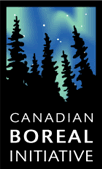 On January 31, 2006, the Canadian Boreal Initiative (CBI) released a report that estimates the ecological goods and services provided by nature in the Mackenzie watershed region to be 10 times the total economic value generated by natural capital extraction industries and other activities within the watershed - close to $500 billion.
On January 31, 2006, the Canadian Boreal Initiative (CBI) released a report that estimates the ecological goods and services provided by nature in the Mackenzie watershed region to be 10 times the total economic value generated by natural capital extraction industries and other activities within the watershed - close to $500 billion.The Mackenzie region is located within Canada's boreal forests, which are able to store more carbon dioxide - a greenhouse gas - than any other similar ecosystem on Earth, including tropical rain forests. Trees and peat lands absorb and store carbon as part of photosynthesis and release oxygen. One of the authors' main arguments is that traditional economic gauges such as gross domestic product don't fully calculate the output of assets in a country. The authors of the report attempt to put numbers on an "ecosystem services product," estimating that 17 services ranging from climate stabilization (the value of carbon uptake and storage) and water supply to recreation and food production are worth about $450-billion a year if the region is in pristine condition, that is, undamaged by industrial and human disturbance. The estimated GDP of the Mackenzie - driven mostly by the extraction of mining, oil, gas, forestry and agricultural sectors watershed was estimated at $41 billion in 2005. The proposed Mackenzie Valley natural gas pipeline, a 1,200-kilometre link that aims to connect the Mackenzie Delta with Alberta, would likely result in additional widespread development. The report, The Real Wealth of the Mackenzie Region, is authored by two ecological economists Sara Wilson and Mark Anielski. "This report is the first watershed-based natural capital review in Canada, if not the world", said Mark Anielski. "Canadians want sustainable development, but we also value clean air, clean water, and the countless other services that nature provides. Our country has been richly endowed, but these ecological services do not count towards our Gross Domestic Product (GDP) - the traditional measure of economic progress. We need to start counting the value of our natural capital so we can make informed stewardship decisions that balance broader ecosystem and cultural values with sustainable economic growth." Some statistics:
 Download the CBI backgrounder on The Real Wealth of the Mackenzie Region (PDF) Download the CBI backgrounder on The Real Wealth of the Mackenzie Region (PDF) Download the CBI report, The Real Wealth of the Mackenzie Region (PDF) Download the CBI report, The Real Wealth of the Mackenzie Region (PDF)CPAWS Wildlands League  In December 2006, CPAWS Wildlands League released a report, Roads: More than lines on a map. The report is intended to provide the public and decision makers with key information on the problem of roads and possible solutions by depicting the need to maintain our shrinking areas of intact forest habitat with what seems to be constant demand for new roads.
In December 2006, CPAWS Wildlands League released a report, Roads: More than lines on a map. The report is intended to provide the public and decision makers with key information on the problem of roads and possible solutions by depicting the need to maintain our shrinking areas of intact forest habitat with what seems to be constant demand for new roads. Visit the Wildlands League's webpage for the report  Download the backgrounder on this project (PDF) Download the backgrounder on this project (PDF)  Download the report, Roads: More than lines on a map (PDF) Download the report, Roads: More than lines on a map (PDF) Download a Canada-wide roads map on proposed road development in intact boreal forest (PDF) Download a Canada-wide roads map on proposed road development in intact boreal forest (PDF)Download case studies from across Canada highlighting different aspects of roads issues:  Yukon (PDF) Yukon (PDF) NWT (PDF) NWT (PDF) Alberta (PDF) Alberta (PDF) Manitoba (PDF) Manitoba (PDF) Newfoundland Labrador (PDF) Newfoundland Labrador (PDF)National Round Table on the Environment and the Economy Reports  The National Round Table on the Environment and the Economy (NRTEE) established the Securing Canada's Natural Capital: The Boreal Forest program "to examine how to advance conservation in balance with economic activity on public lands allocated for resource development in Canada's boreal through regulatory and fiscal policy reform".
The National Round Table on the Environment and the Economy (NRTEE) established the Securing Canada's Natural Capital: The Boreal Forest program "to examine how to advance conservation in balance with economic activity on public lands allocated for resource development in Canada's boreal through regulatory and fiscal policy reform".In October 2005, the NRTEE released the report, Boreal Futures: Governance, Conservation and Development in Canada's Boreal, which cautions that this precious resource has been affected seriously in recent decades by logging, mining and energy extraction and global warming.  The report makes seven recommendations in four areas of governance - leadership, education, and information; ecological fiscal reform; innovations in planning and regulatory frameworks; and institution and capacity-building. The seven recommendations are:
The report makes seven recommendations in four areas of governance - leadership, education, and information; ecological fiscal reform; innovations in planning and regulatory frameworks; and institution and capacity-building. The seven recommendations are:
 Download October 2005 NRTEE report Boreal Futures: Governance, Conservation and Development in Canada's Boreal (PDF) Download October 2005 NRTEE report Boreal Futures: Governance, Conservation and Development in Canada's Boreal (PDF)In 2003, the National Round Table on the Environment and the Economy (NRTEE) released a report, Securing Canada's Natural Capital: A Vision for Nature Conservation in the 21st Century. Although not exclusively about the boreal forest, the 20 recommendations which are aimed at furthering conservation in Canada are pertinent to the need to protect Canada's boreal. In its report, the NRTEE calls for federal government action in five key areas:
Protected Areas Recommendation 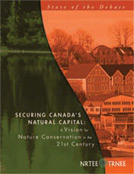 One of the key issues also noted by the NRTEE that underlines the urgency of conservation and protection in the boreal is the failure of planning to keep pace with other pressures on the landscape in Canada; decisions about industrial development are being made more rapidly and in advance of conservation planning.
One of the key issues also noted by the NRTEE that underlines the urgency of conservation and protection in the boreal is the failure of planning to keep pace with other pressures on the landscape in Canada; decisions about industrial development are being made more rapidly and in advance of conservation planning. Canada's boreal forests were highlighted in one of the NRTEE's 20 recommendations. Recommendation 1 states, The Round Table recommends that the federal government accelerate conservation planning in two areas where unique opportunities exist to plan in advance of major industrial development. These areas are... Canada's boreal forests, where the federal government can work with provinces, territories and Aboriginal governments to develop a framework - which includes both protected areas and sustainable management - to sustain and conserve Canada's boreal forests.  Download the National Round Table on the Environment & Economy 2003 report Securing Canada's Natural Capital: A Vision for Nature Conservation in the 21st Century (PDF) Download the National Round Table on the Environment & Economy 2003 report Securing Canada's Natural Capital: A Vision for Nature Conservation in the 21st Century (PDF)Environment Canada Report 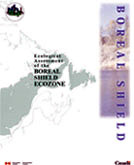 A report prepared by Environment Canada in August of 1998 entitled Ecological Assessment of the Boreal Shield Ecozone identified large scale resource development activities as the single largest human threat to biodiversity in the North American boreal forest ecosystem. Three activities are specifically mentioned by the draft report: large scale commercial logging, mining, and hydro-electric generation. The fact that many areas of the boreal are threatened by development pressures is one of the compelling arguments for protecting boreal forest areas.
A report prepared by Environment Canada in August of 1998 entitled Ecological Assessment of the Boreal Shield Ecozone identified large scale resource development activities as the single largest human threat to biodiversity in the North American boreal forest ecosystem. Three activities are specifically mentioned by the draft report: large scale commercial logging, mining, and hydro-electric generation. The fact that many areas of the boreal are threatened by development pressures is one of the compelling arguments for protecting boreal forest areas. Download the 1998 Environment Canada report: Ecological Assessment of the Boreal Shield Ecozone (PDF) Download the 1998 Environment Canada report: Ecological Assessment of the Boreal Shield Ecozone (PDF)Sources: National Round Table on the Environment & Economy, The Wildlands League 1, 2, Natural Resources Defense Council, Canadian Boreal Initiative, Environment Canada
Wildlands League Boreal Portrait CPAWS Wildlands League in Ontario recently released a geographical 'portrait' of one of the province's northern boreal Ecoregions. The portrait inventories many of the ecological and cultural values of Ontario's northern boreal forest and includes maps that reveal the location of a range of features, from intact forests and watersheds to road corridors and potential hydro transmission corridors. The portrait is of Ecoregion 3S (located just north of Red Lake) and is located within The Lac Seul Upland, which straddles Ontario and Manitoba. Ecoregion 3S lies within the heart of Canada's boreal region and consists of a largely unbroken band of forests, wetlands, lakes and rivers that extends from the Manitoba border in the west to Wabakimi Provincial Park in the east.  Download Within the Lac Seul Upland: a geographical portrait of Ecoregion 3S (PDF) Download Within the Lac Seul Upland: a geographical portrait of Ecoregion 3S (PDF)Visit the CPAWS Wildlands League page on the Ecoregion 3S portrait Source: CPAWS Wildlands League
Boreal Initiatives |
 2002-2014
2002-2014

